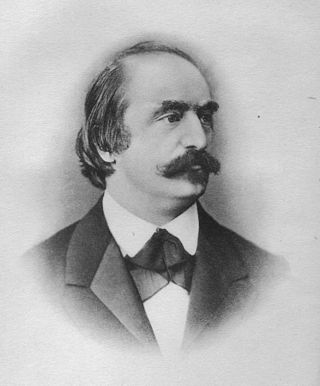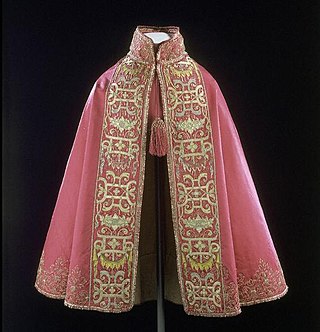Aesthetics is the branch of philosophy concerned with the nature of beauty and the nature of taste; and functions as the philosophy of art. Aesthetics examines the philosophy of aesthetic value, which is determined by critical judgements of artistic taste; thus, the function of aesthetics is the "critical reflection on art, culture and nature".
Restoration is the act of restoring something to its original state. This may refer to:

Textile is an umbrella term that includes various fiber-based materials, including fibers, yarns, filaments, threads, different fabric types, etc. At first, the word "textiles" only referred to woven fabrics. However, weaving is not the only manufacturing method, and many other methods were later developed to form textile structures based on their intended use. Knitting and non-woven are other popular types of fabric manufacturing. In the contemporary world, textiles satisfy the material needs for versatile applications, from simple daily clothing to bulletproof jackets, spacesuits, and doctor's gowns.

Eduard Hanslick was an Austrian music critic, aesthetician and historian. Among the leading critics of his time, he was the chief music critic of the Neue Freie Presse from 1864 until the end of his life. His best known work, the 1854 treatise Vom Musikalisch-Schönen, was a landmark in the aesthetics of music and outlines much of his artistic and philosophical beliefs on music.
Technique or techniques may refer to:
First or 1st is the ordinal form of the number one (#1).

In aesthetics, the sublime is the quality of greatness, whether physical, moral, intellectual, metaphysical, aesthetic, spiritual, or artistic. The term especially refers to a greatness beyond all possibility of calculation, measurement, or imitation.
Blur, Blurry, Blurring, Blurred or Blurr, may refer to:

Windows Aero is the design language introduced in the Microsoft Windows Vista operating system. The changes introduced by Windows Aero encompassed many elements of the Windows interface, with the introduction of a new visual style with an emphasis on animation, glass, and translucency; interface guidelines for phrasing and tone of instructions and other text in applications were available. New cursors and sounds based on Windows Aero design principles were also introduced.

Japanese aesthetics comprise a set of ancient ideals that include wabi, sabi, and yūgen. These ideals, and others, underpin much of Japanese cultural and aesthetic norms on what is considered tasteful or beautiful. Thus, while seen as a philosophy in Western societies, the concept of aesthetics in Japan is seen as an integral part of daily life. Japanese aesthetics now encompass a variety of ideals; some of these are traditional while others are modern and sometimes influenced by other cultures.
This is a history of aesthetics.
Beauty is an aesthetic characteristic.
Applied aesthetics is the application of the branch of philosophy of aesthetics to cultural constructs. In a variety of fields, artifacts are created that have both practical functionality and aesthetic affectation. In some cases, aesthetics is primary, and in others, functionality is primary. At best, the two needs are synergistic, in which "beauty" makes an artifact work better, or in which more functional artifacts are appreciated as aesthetically pleasing. This achievement of form and function, of art and science, of beauty and usefulness, is the primary goal of design, in all of its domains.
The following outline is provided as an overview of and topical guide to aesthetics:
Indian art evolved with an emphasis on inducing special spiritual or philosophical states in the audience, or with representing them symbolically.

Aesthetics in textiles is one of the basic concepts of serviceability of textiles. It is determined by the perception of touch and sight. Aesthetics imply the appearance and attraction of textile products; it includes the color and texture of the material. It is a statement about the end user (consumer) and the target market. When combined with fabric construction, the finish of the clothing material, garment fit, style, and fashion compatibility, colours create an aesthetic comfort. All of these elements work together to satisfy our visual perception. Aesthetics incorporates the role of evaluation also.
An Internet aesthetic, also simply referred to as an aesthetic or microaesthetic, is a visual art style, sometimes accompanied by a fashion style, subculture, or music genre, that usually originates from the Internet or is popularized on it. Throughout the 2010s and 2020s, online aesthetics gained increasing popularity, specifically on social media platforms such as Tumblr, Pinterest, Instagram and TikTok, and often were used by people to express their individuality and creativity. They can also be used to create a sense of community and belonging among people who share the same interests. The term aesthetic has been described as being "totally divorced from its academic origins", and is commonly used as an adjective.





